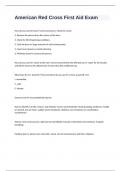American Red Cross First Aid Exam
How do you care for burns? correct answers1. Check the scene.
2. Remove the person from the source of the burn.
3. Check for life threatening conditions.
4. Cool the burn w/ large amounts of cold running water.
5. Cover burn loosely w/ sterile dressing.
6. Minimize shock & reassure the person.
How do you care for a burn to the eye? correct answersFlush the affected eye w/ water for 20 minutes
and tilt the head so the affected eye is lower than the unaffected eye.
What does R.I.C.E. stand for? How and when do you use it? correct answersR- rest
I- immobilize
C- cold
E- elevate
General care for musculoskeletal injuries.
How to identify a stroke, seizure, and fainting? correct answersStroke: facial drooping, weakness, trouble
w/ speech, loss of vision, sudden severe headache, dizziness, loss of balance or coordination,
incontinence.
Seizure: lose consciousness, rigid and uncontrollable muscular contractions (convulsions), irregular
breathing
Fainting: pale or ashen cool, moist skin, sweat, loss of consciousness and then collapses.
, How do you care for a seizure? correct answersProtect the person from injury by moving nearby objects
away from the person. After seizure passes position the person on his or her side in a modified
H.A.IN.E.S recovery position.
How are strokes caused? correct answersBlood flow to a part of the brain is cut off or when there is
bleeding into the brain.
What are some signs of a stroke? correct answersfacial drooping, weakness, trouble w/ speech, loss of
vision, sudden severe headache, dizziness, loss of balance or coordination, incontinence.
What does FAST stand for? correct answersF- face
A- arm
S- speech
T- time
How is a diabetic emergency caused? correct answersThere is an imbalance between sugar and insulin in
the body.
How do you care for a diabetic emergency? correct answersGive sugar in the form of several glucose
tablets or glucose pasted or a 12-ounce serving of fruit juice (Orange juice), milk, non diet soft drink or
table sugar dissolved in a glass of water.
How do you care for a possible head, neck, or spine injury? correct answersMaintain an open airway, call
9-1-1, and while waiting: minimize movement of head, neck, and spine w/ manual stabilization; check for
life threatening conditions; monitor for consciousness & breathing, stabilize penetrating object, minimize
shock.
What are some signs of a possible head, neck, or spine injury? correct answersChanges in level of
consciousness, severe pain or pressure in the head, tingling or loss of sensation in the extremities, partial
or complete loss of movement of any body part, unusual bumps or depressions, sudden loss of memory,
blood or other fluids in the ears or nose, profuse external bleeding of the head, seizure, impaired
breathing, nausea, persistent headache, loss of balance, bruising of the head (around the eyes of behind
the ears).




